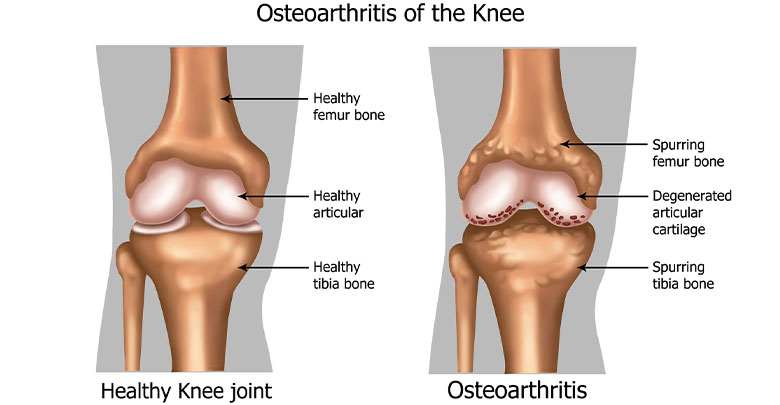The Symptoms and Causes of Osteoarthritis Explained
Do you have osteoarthritis? Use our common cause list and review your symptoms

Do you have osteoarthritis? Use our common cause list and review your symptoms
Osteoarthritis, also known as the “wear and tear” arthritis, is the most common form of arthritis and is loosely associated with aging. This form of arthritis occurs when the protective layer of cartilage between the bones in the joints start to degenerate, leaving the cartilage thinner and the joint surfaces rougher. Would like to know about the symptoms and causes of osteoarthritis?
USE the OMH exclusive code "HEALTH15" to Save 15%
Osteoarthritis can occur in any joint, but is most common in the knees and hips, followed by the fingers, spine and toes.
Symptoms of osteoarthritis
Symptoms of osteoarthritis develop slowly and worsen over time. The most common symptoms are:
- Pain in the joints during or after movement
- Stiffness in the joints after sleep or periods of inactivity
- Tenderness when light pressure is applied to the joint area
- Loss of flexibility as the range of motion of the joints decrease
- Grating sensation when the joint is used, some people can hear popping or crackling sounds
- Boney spurs or hard bumps can form around the joints (called osteophytes). Sometimes small fragments of bone or cartilage break off and float inside the joints space, leading to more pain and damage to the joint
- Swelling is common as a result of inflammation of the soft tissue around the joint

Pain, swelling and stiffness make carrying out normal activities of daily living and of ordinary tasks difficult. Simple tasks like making your bed, opening boxes, driving a car, doing or undoing buttons, walking, climbing stairs, and lifting of objects can become challenging. When the affected joints are in the hands it can become difficult to grasp or hold objects.
What causes osteoarthritis?
- Age is a major cause – the longer the joints have been in use, the more wear and tear they would have had to endure. Osteoarthritis is mostly found in people of 40 years and older due to the way the body changes with age. The muscles tend to weaken (due to loss of muscle mass), and there might be weight gain.Generally the body’s healing time and repair processes get slower.
- Gender – more women than men develop osteoarthritis.
- Obesity – being overweight can lead to more wear and tear on the weight-bearing joints like the knees and hips.
- Joint injuries – a previous injury can lead to osteoarthritis in the joints in later life. Normal activity and exercise will not lead to osteoarthritis, but hard, repetitive tasks can, over time, lead to irreversible joint damage.
- Misalignment of the lower extremities, like knock knees and bow-legs – these alignment issues cause chronic biomechanical stress on the cartilage which will progress to cartilage deterioration.
- Genetic factors – some people’s genetic make-up predisposes them to developing osteoarthritis.
- Other joint diseases – Rheumatoid arthritis and gout can increase the possibility of someone developing osteoarthritis as an associated condition.
Although weather cannot cause osteoarthritis, changes in weather often worsen the pain experienced. Many people report an increase in pain before rainfall. This is most likely related to the barometrical changes happening around meteorological events. Diet per se can also not cause osteoarthritis. However extra weight will put more strain on joints leading to a faster degeneration of the protective cartilage. Maintaining a healthy and balanced diet will help you to keep your joints healthy, or to slow down the progression of already existing osteoarthritis.
Check out our Oh.My.Health healthy recipes for a balanced diet.
References
1. Mora JC et al. 2018 https://www.ncbi.nlm.nih.gov/pmc/articles/PMC6179584/
2. Chen D et al 2016 https://www.ncbi.nlm.nih.gov/pmc/articles/PMC5240031/
3. Ashkavand Z et al. 2013 https://www.researchgate.net/publication/257434938_The_pathophysiology_of_osteoarthritis
4. Michael JPW et al. 2010 https://www.ncbi.nlm.nih.gov/pmc/articles/PMC2841860/
5. Hunter DJ et al. 2008 https://www.sciencedirect.com/science/article/abs/pii/S0889857X08000367
6. Litwik A et al. 2013 https://academic.oup.com/bmb/article/105/1/185/271633
7. Jordan JM et al. 2007 http://www.jrheum.org/content/34/1/172.short
8. Nguyen USDT et al. 2011 https://annals.org/aim/article-abstract/1033191/increasing-prevalence-knee-pain-symptomatic-knee-osteoarthritis-survey-cohort-data